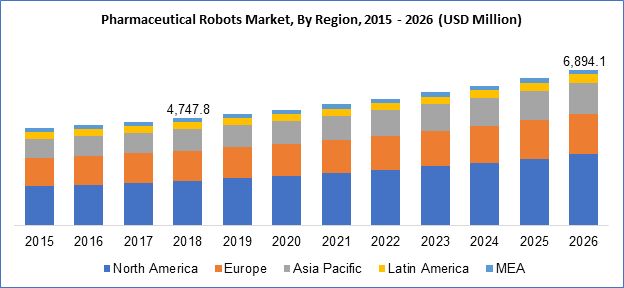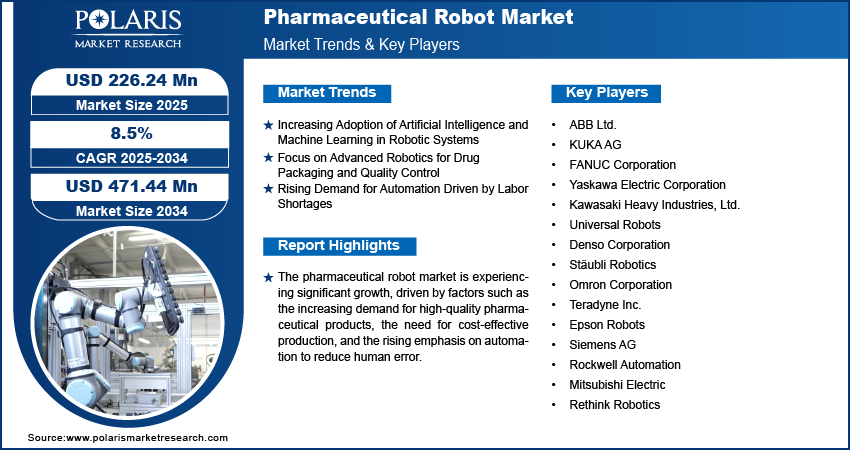
Pharmaceutical Robots Market Share, Size, Trends, Industry Analysis Report By Product Type (Traditional Robot (Articulated, SCARA, Delta/Parallel, Cartesian, Dual-Arm), Collaborative Robot); By Application (Picking and Packaging, Laboratory Applications, Inspection of Pharmaceutical Drugs); By End Use (Biopharmaceutical Companies, Research Laboratories); By Regions, Segments & Forecast, 2019 - 2026
- Published Date:May-2019
- Pages: 105
- Format: PDF
- Report ID: PM1517
- Base Year: 2018
- Historical Data: 2015-2017
Report Outlook
The global pharmaceutical robots market size was estimated to be $4,747.8 million in 2018 and is anticipated to have a profitable growth from 2019 to 2026. Pharmaceutical Robots are gaining entry into the proverbial pharmaceutical industry with automation and with reduced human intervention in routine functions. These functions include automated inspection and packaging which is the primary function of pharmaceutical industry. The other areas of consideration include filling, packaging and assisting in manufacture of customized medicines. The robots in addition derive maximum efficiency, save cost excesses by minimum training lessons and save workers from potentially hazardous environment. They also reduce additional workloads by reducing margin of human errors and prevents ingress of dirt in medicines. Increased reliability is very much a foregone conclusion.
North America solely accounted for nearly 34% in primary pharmaceutical packaging vertical espousing exponential growth, with robots as the primary helping arm, as per Association for Packaging and Processing Technologies. The global pharmaceutical robots market is driven primarily by its expansive reach in pharmaceutical industry with an intense need for automation in the pharma vertical. A reduction in errors by human intervention is a yet another driving factor for the growth in this market. Adoption of such mechanism leads directly into cost savings in human labor leading to reduction in production cost, thus driving the growth of the market.

Know more about this report: request for sample pages
Pharmaceutical manufacturing companies need the selective use of automated machines for quick accomplishment of tasks. There is massive amount of work in pharmaceutical industries which require unobstructed use of pharma machines. These machines assist in drug discovery, development and inspection and are a boon to drug manufacturing companies.
The global market is categorized on the basis of product, application, end-use and geography.
On the basis of product, pharma robots are classified into traditional and collaborative. The traditional segment is observed to hold a dominant market amongst the two but the collaborative segment occupy major market share during forecast period on account of simple maintenance as compared to traditional ones. The benefits offered by this technology in the pharmaceutical space include high speed, efficient track and trace and covering of optimal floor space.
Traditional robots are further segmented into articulated, Scara, delta/parallel, cartesian and dual arm. Articulated robots hold majority market share owing to their capability to check packed product at the manufacturing plant. M-430iA manufactured by Fanuc Corporation which unloads diagnostic kits is an instance of such technology. Scara have dominant market share in this market during the forecast period because the machines in use are relatively cheaper than ones in use in other categories.
The collaborative robots’ segment is slated to reach maximum CAGR in forecast period due to new technology that keeps interaction between humans and robots on. The machines come cheaper and are easier to maintain than traditional ones. The collaborative robots are lightweight and handling need no special training.

Know more about this report: request for sample pages
Pharmaceutical Robots Market Report Scope
By Robots Product |
By Application |
By End-Use |
By Region |
|
|
|
|
Know more about this report: request for sample pages
Application Outlook
The global pharmaceutical robots market is segmented on the basis of application type, covers picking and packaging, laboratory applications and inspection of pharmaceutical drugs. Inspection of pharmaceutical drugs remains most attractive segment in the market which is due to government interventions and compliance of strict policies regarding drug approvals. Inspection type pertains to cracks on the tablet, color inspection, shape recognition counting of tablets and cross-checking package for any leakage present. Laboratory automation is an emerging market in the field of robotics. Laboratory application is credited with maximum share in the market during forecast period because of reduced human intervention in the drug manufacturing stages. Robotic applications include reducing repetitive work of capping, uncapping and manual pipettes.
End-User Outlook
End-user comprises biopharmaceutical companies and research laboratories. Biopharmaceutical Devices to retain market lead due to increasing drug discovery in company with awareness for manufacturing process of customized medicines and currently undertaken clinical trials. Pharmaceutical segment is a developing segment in the field of industrial robots. Companies are launching new and advanced robotic machines which will result in boom in the market. Collaborative robots (cobots) such as UR3 by Universal Robots which assist in picking and placing, lab analysis and injection molding are upgrading manufacturing units with new technology.
Regional Outlook
By geography, the market is segmented into North America, Europe, Asia Pacific, Latin America and MEA. Asia Pacific is expected to grow at a fast pace because of rising company outgo on various processes undertaken in pharma industry. A cumulative and decent growth to domestic companies, thriving pharmaceutical companies, plethora of conventions and exhibitions and investment flushed with funding has seen Asia Pacific to look at flourishing growth in the market.
North America is also witness to infectious growth in forecast period. 10-15 % growth has been earmarked for the sector that would activate hefty growth in the near future. Furthermore, upcoming landmark number of pharmaceutical companies and the potential R&D efforts for new drug launches and various customized medicines are redeem ng factors in North American pharmaceutical robot industry. Growing standards of automation in pharmaceutical industries in United States to increase production efficiency of manufacturing units has fueled growth in robotics arm.
Europe also showcases high growth in Market owing to penetration of robotics in Germany. Annual sales of machines in Germany was very high in 2015 making Germany 5th highest market with rate of adoption. Furthermore, European Union is taking steps to maintain regulatory standards for safety in its field.
Competitive Analysis
The key players operating in the Pharmaceutical robots market include Kawasaki Heavy Industries Ltd., Fanuc America Corporation, ABB Ltd., Yaskawa Electric Corporation, Denso Wave Inc., Seiko Epson Corporation, Marchesini Group S.p.A and Universal Robots A/S.

